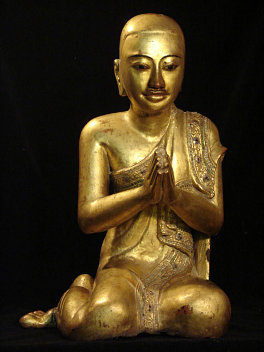GREETINGS

A greeting is something said or done on meeting a person. In ancient India there were several forms of respectful and polite greetings. The most common was to bow the head (paõàma) and put the hands in a praying gesture (a¤jalã, D.I,118; M.I,168). Sometimes while doing this one would exchange friendly words with the person being greeted or inquire about their health (D.I,52; A.I,66). In Buddhist countries this remains the most common form of greeting between monks, by lay people to monks and between lay people.
The Nàtya÷àstra says there are three forms of this greeting; with the hands put to the head, in front of the face or in front of the chest and they are given to the gods, to teachers and to friends respectively. To express more respect one might bow the head, put the hands in a praying gesture and get down on one knee or even on both knees (Thi.109). Not necessarily more respectful but certainly more elaborate, was to get down on both knees and put one's head at the person's feet.The most elaborate greeting was to lie prostrate while stroking and kissing the person's feet (M.II,120; S.I,178). This was called `lying prone like a stick' (daõóapaõàma).
When people went to meet the Buddha they always found him `welcoming, friendly, polite, genial, engaging, and the first to speak' (D.I,116), and while he accepted greetings and gestures of respect from others, he was not overly concerned about whether or not this was done or how it was done. After a man named Sonadaõóa took the Three Refuges, he confided to the Buddha that he had a particular problem. He was a brahmin and his income depended on the respect in which other brahmins held him. If they saw him bowing to the Buddha he would lose the respect of his peers and his income would suffer. `So if on entering the assembly hall I put my hands together in greeting, consider it the same as if I had stood up for you. If on entering the assembly I remove my turban consider it the same as if I had bowed at your feet. If, when riding in my chariot, I were to get down to salute you, others would criticize me. So if I pass you in my chariot and I just lower my head, consider it the same as if I had got down and bowed at your feet' (D.I,125-6). The Buddha had no problems with Sonadaõóa's way of paying respect, presumably because he had sympathy with his predicament and because social formalities were of minor importance to him. See Hospitality.